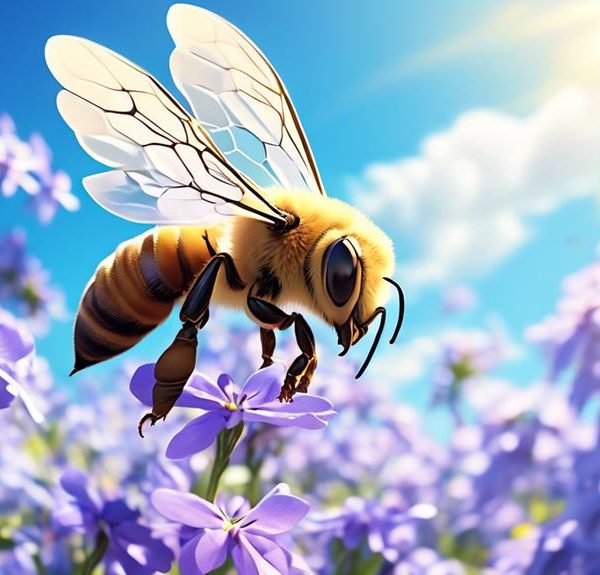Mysteries of nature unveiled: delve into why bees are irresistibly drawn to the color blue and the science behind their color preferences.
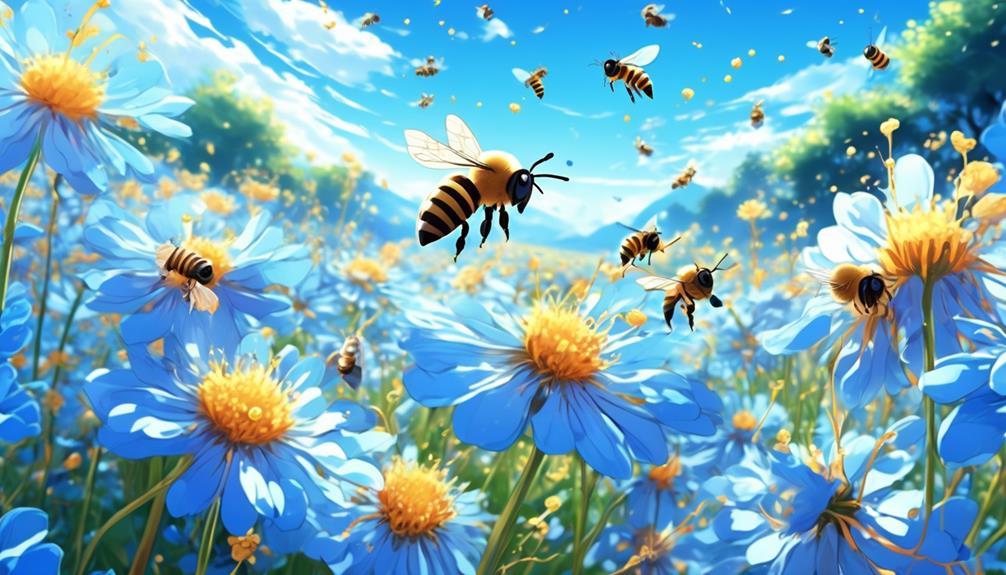
Do Bees Like Blue
Imagine standing in a thriving garden, awash with the buzz of bees as they dart from blossom to blossom, their tiny bodies dusted with pollen. You've probably noticed they seem particularly drawn to certain colors, haven't you? Blue, for instance, seems to be a magnet for these industrious pollinators.
But why, you might ask, do bees prefer blue? It's not all in your head, you know. Bees do display an intriguing preference for blue, a phenomenon that's been the subject of numerous scientific studies.
So, let's embark on a fascinating journey into the world of bee vision, color attraction, and unravel the special relationship between bees and the color blue.
Key Takeaways
- Bees perceive colors differently from humans, with their vision focused on ultraviolet, blue, and green.
- Bees are particularly attracted to blue and violet flowers due to their high reflection of ultraviolet light.
- The affinity for blue promotes cross-pollination and sustains biodiversity through effective pollination.
- Incorporating more blue elements into gardens, landscapes, and urban spaces supports bee survival and conservation efforts.
Understanding Bee Vision
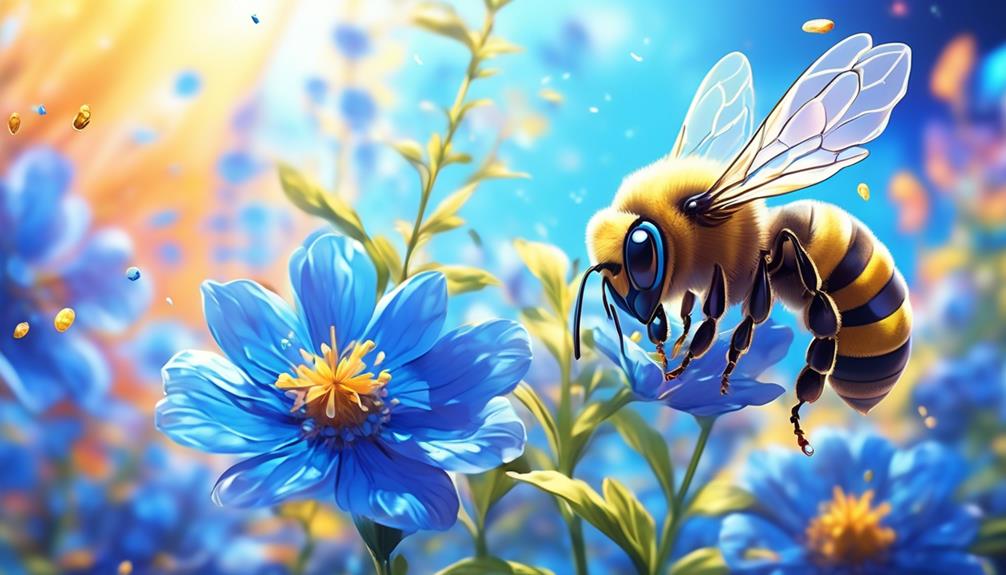
To truly grasp why bees may be attracted to the color blue, you'll need to dive into the complex world of bee vision, a fascinating interplay of biology and physics. Unlike humans, bees perceive colors differently due to their unique photoreceptor cells. They see colors in the spectrum of ultraviolet, blue, and green, completely missing out on the red spectrum. It's science, not preference.
Now, why blue? The answer lies in the bee's survival strategy. Bees associate blue and ultraviolet patterns with nectar-rich flowers, thus making blue an effective attractant. This isn't just a mere preference but an evolutionary advantage. The bees' preference for blue enables them to efficiently locate and remember the position of their food sources, enhancing their survival rates.
Furthermore, the petals of many flowers contain ultraviolet patterns only visible to bees, acting as a beacon signaling the presence of nectar. These patterns, often appearing blue to bees, guide them to the flower's center, ensuring pollination.
Attraction to Different Colors
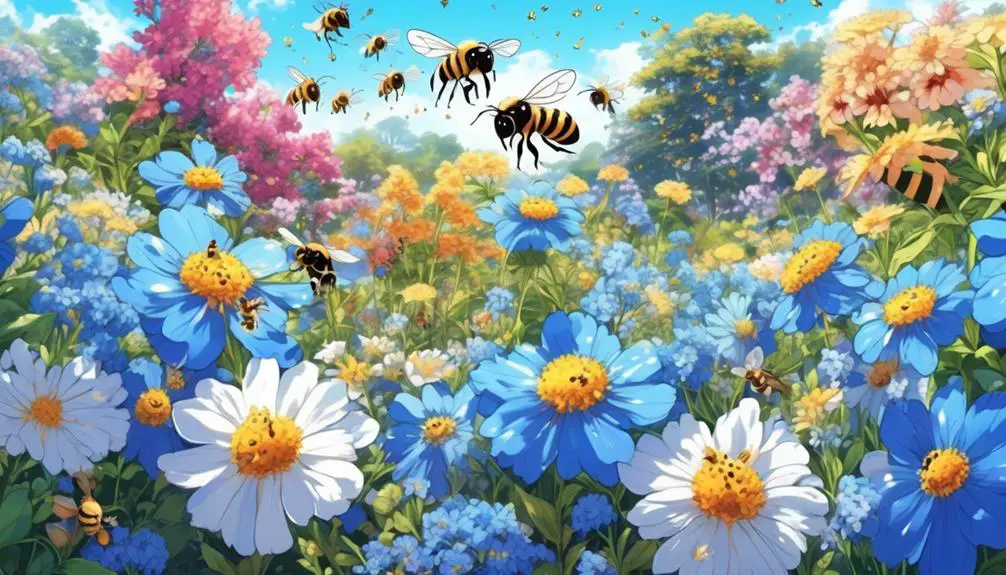
While blue holds a special place in the bee's color spectrum due to its association with nectar-rich flowers, bees don't limit their attention to this hue alone. Contrary to common belief, bees aren't colorblind and do perceive a wide array of colors. However, their color vision differs significantly from yours.
Bees see the world in a combination of blue, green, and ultraviolet light, which is invisible to human eyes. They're particularly attracted to blue and violet flowers because these colors reflect a lot of ultraviolet light. This makes them appear brighter and more appealing to bees.
On the other hand, bees struggle to distinguish between red and green. They often perceive these colors as shades of their primary color perception, making red flowers appear as a dull green or even black.
It's essential to understand that bees' color preferences aren't just based on aesthetics. The colors they're attracted to typically indicate the presence of nectar, helping them find food sources more efficiently. Studying their color preferences can provide insight into bees' behavior and contribute to efforts in preserving these vital pollinators.
Blue and Bees: A Special Relationship
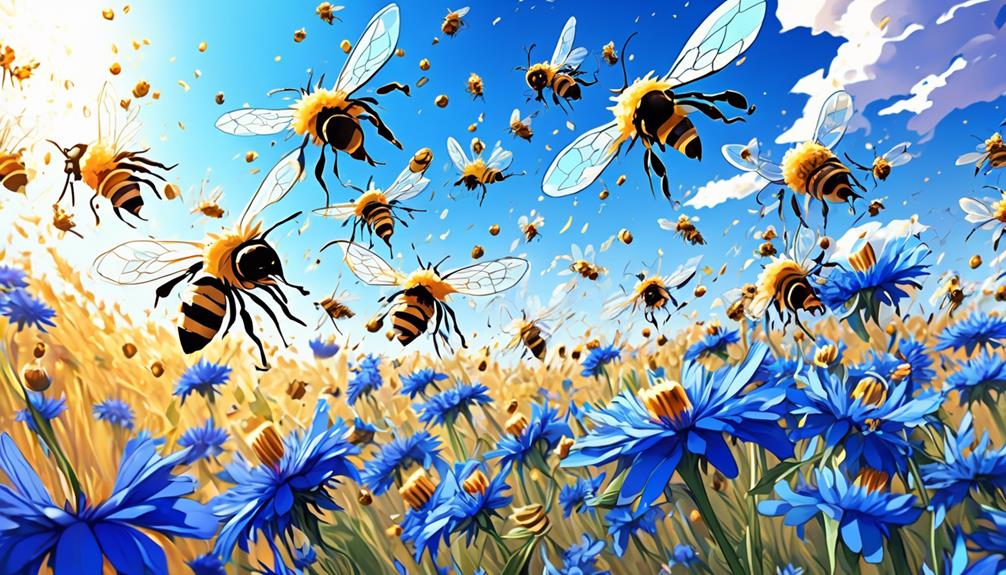
In the fascinating world of bees, blue takes on a unique significance, serving as a beacon that often leads these industrious insects to nourishing nectar sources. You may wonder why this is. Well, bees have a special relationship with the color blue due to their unique vision abilities.
Unlike humans, bees perceive color differently, they can't see red but can detect ultraviolet light, which we can't. Their spectrum ranges from ultraviolet to blue-green. This makes blue and violet flowers particularly attractive to them.
Interestingly, this isn't by chance. Many plants have evolved to take advantage of bees' preference for blue. They've developed blue pigments, often in patterns only visible under ultraviolet light, which guide bees to their nectar. This is a win-win, as it helps plants to pollinate, and bees to find food efficiently. This synergy has shaped the ecology of our planet.
Also, bees' attraction to blue isn't just about sight. Recent studies suggest that flowers can generate weak electric fields that bees can sense. It turns out, blue flowers produce stronger signals, making them even more enticing. This fascinating interplay between bees and blue continues to be a focus of scientific research.
Influence of Blue on Bee Pollination
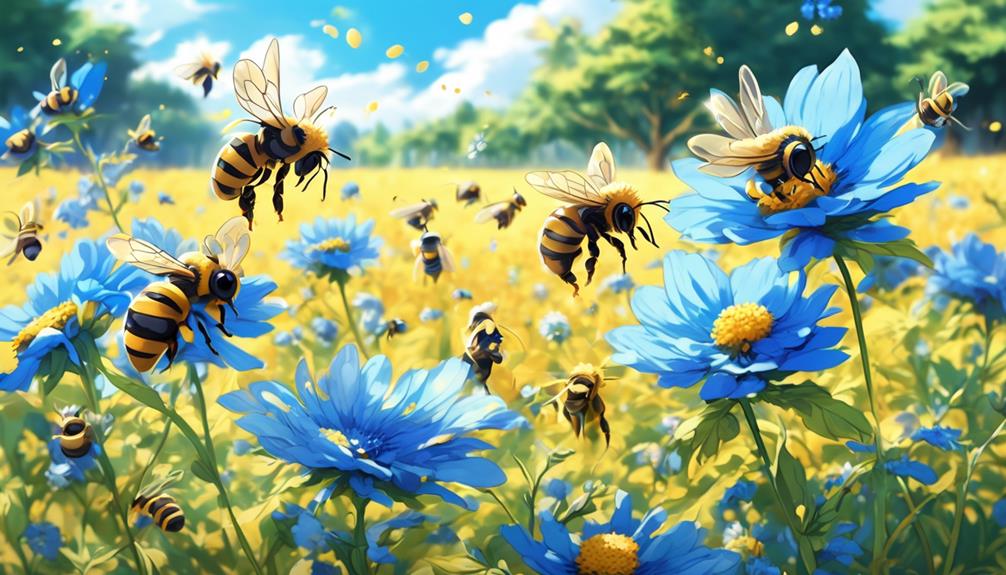
Building on this special relationship between bees and the color blue, let's explore how this preference significantly influences bee pollination.
You must understand, bees' affinity for blue isn't just a trivial quirk; it has profound implications for our ecosystem. When bees forage, they're drawn to blue flowers, thereby promoting cross-pollination. As they move from bloom to bloom, pollen sticks to their bodies and is transported to other flowers, ensuring the survival of plant species.
Scientific studies have repeatedly shown that blue flowers, especially those with ultraviolet patterns, attract more bees than other colors. This isn't a mere coincidence. Bees' vision is optimized for the blue and ultraviolet end of the light spectrum, allowing them to find nectar-rich flowers with greater efficiency.
The color blue can also influence the timing and pattern of bee foraging. It's been observed that bees can learn to associate blue with rich nectar sources and adjust their foraging schedule accordingly. So, with more blue flowers in an area, you'll likely see a boost in bee activity and, ultimately, more effective pollination.
In this way, the humble bee's preference for blue plays a critical role in sustaining biodiversity.
Scientific Studies on Bees and Blue
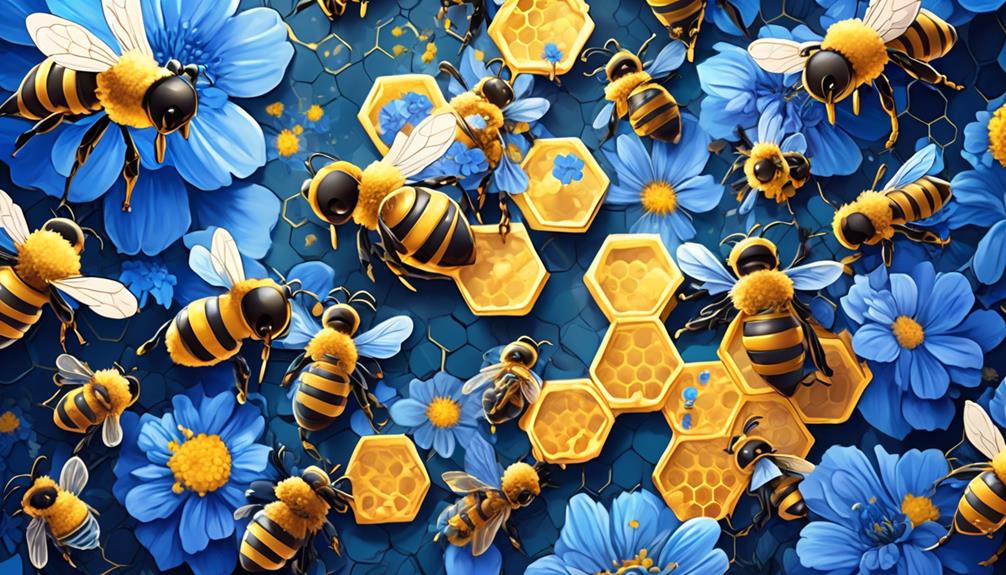
Let's delve into the numerous scientific studies that have been conducted to understand why bees are so attracted to the color blue.
The first thing to note is that bees don't see colors the same way we do. They can't see red, but they can see ultraviolet – a color spectrum that's invisible to us.
Scientists have discovered that bees are particularly drawn to blue and violet flowers because they appear more vivid to them. This is due to the unique way their eyes process light. The blue and ultraviolet wavelengths resonate strongly with their photoreceptors, making these colors more attractive to them.
In a study at the University of Nevada, researchers found that bees can remember the specific color of a flower that gave them a good nectar reward. When the flower is blue or violet, it's easier for the bee to remember and return to it.
Another study from the Free University of Berlin showed that bees can even learn to associate the color blue with a food reward. Through this conditioning, they start to favor blue even more.
Scientific research continues to unearth fascinating insights into why bees prefer blue. So next time you're choosing flowers for your garden, remember – bees love blue!
Practical Applications of Bees' Love for Blue
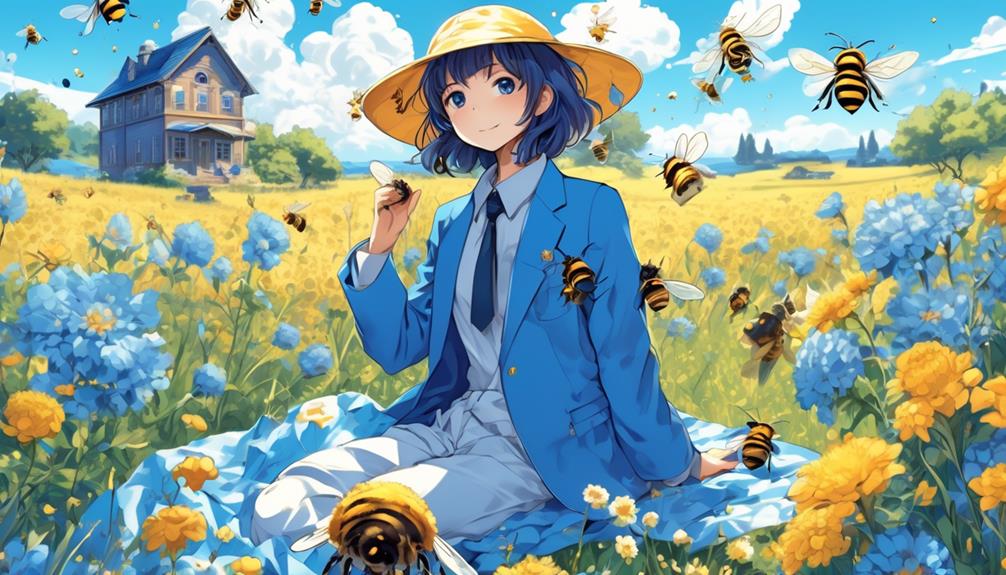
Understanding the practical applications of bees' attraction to blue can greatly enhance our efforts in bee conservation and agricultural productivity. It's not just about being aware of their color preference; it's about leveraging this knowledge for their and our benefit.
By incorporating more blue flowers into our gardens and landscapes, we're providing bees with more of what they're naturally drawn towards. This not only aids in their survival but also ensures effective pollination, a process integral to our food production.
In agriculture, farmers can use blue 'bee boards' or other visual cues to attract bees to specific areas needing increased pollination. Even in urban areas, city planners can incorporate blue elements into public spaces to support local bee populations, contributing to urban biodiversity.
Moreover, this knowledge could help develop innovative bee-friendly pest control measures. For instance, blue traps could be designed to lure harmful insects, sparing bees and other beneficial insects from harmful pesticides.
Finally, in bee conservation efforts, understanding their attraction to blue can enhance the design of man-made bee habitats. By incorporating blue, we can make these refuges more appealing, increasing their effectiveness.
In essence, the bees' love for blue isn't just an interesting fact; it's a tool we can use to support their survival and our agricultural success.
Frequently Asked Questions
How Can the Color Preference of Bees Potentially Affect the Biodiversity of Plants?
Bees' color preference can significantly influence plant biodiversity. If bees favor certain colors, they'll likely pollinate those plants more frequently. This accelerates the reproductive cycle of those plants, leading to a higher population.
Meanwhile, plants of less attractive colors might be pollinated less, reducing their numbers. So, your garden's color palette might indirectly shape its biodiversity, with bees as the inadvertent gardeners.
Are There Different Types of Bees That Prefer Different Colors, or Is Blue Universally Liked by All Bees?
Yes, different types of bees do show varying color preferences.
It's not universally true that all bees prefer blue. For instance, honeybees are more attracted to violet and blue, whereas bumblebees tend to favor purple and violet flowers.
Such preferences can influence their foraging behavior and subsequently, the pollination of various plant species.
It's a fascinating aspect of bee biology that contributes significantly to our ecosystem's biodiversity.
How Does the Color Preference of Bees Impact the Beekeeping Industry?
Your beekeeping efforts can be significantly impacted by bees' color preferences. Bees, particularly honeybees, are drawn to blue and violet hues. This attraction is tied to their foraging habits.
If you're planting flowers to attract bees, choosing those colors can increase your success. Conversely, if you're trying to keep bees away, avoiding these colors in your garden design might help.
Understanding these preferences can help you manage your bee population more effectively.
How Can Gardeners or Farmers Use the Knowledge of Bees' Color Preferences to Their Advantage?
Understanding bees' color preferences can greatly improve your gardening or farming efforts. By planting more flowers in their preferred colors, you'll attract more bees, increasing pollination. It's crucial to keep a variety of colors, as bees are attracted to a diverse range.
However, research shows bees favor blue and violet, so including more of these might give your garden an extra boost. This knowledge directly contributes to a healthier, more productive ecosystem.
Are There Any Other Animals or Insects That Share the Same Color Preference as Bees?
Yes, there are other creatures that share bees' color preference. For instance, butterflies also favor blue. They're attracted to the ultraviolet spectrum, which blue is a part of.
Similarly, birds like blue jays and bluebirds are drawn to blue. However, it's important to note that color preference isn't just about attraction. It can also be about camouflage or signaling danger to predators.
Conclusion
In conclusion, you've discovered bees' remarkable affinity for blue. This color not only attracts bees but also influences their pollination patterns. Scientific studies have proven this blue preference, opening up practical applications in agriculture and conservation efforts.
So next time you're gardening, remember, planting blue flowers isn't just a design choice, it's a bee-friendly one too. Indeed, understanding the world from a bee's perspective can illuminate our own role in supporting these vital pollinators.


